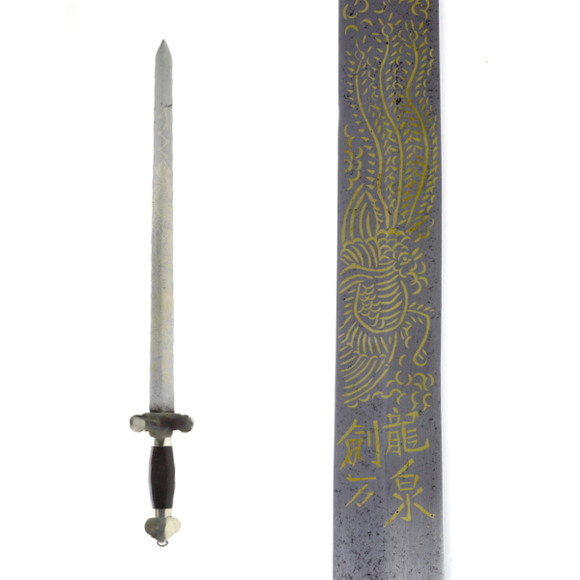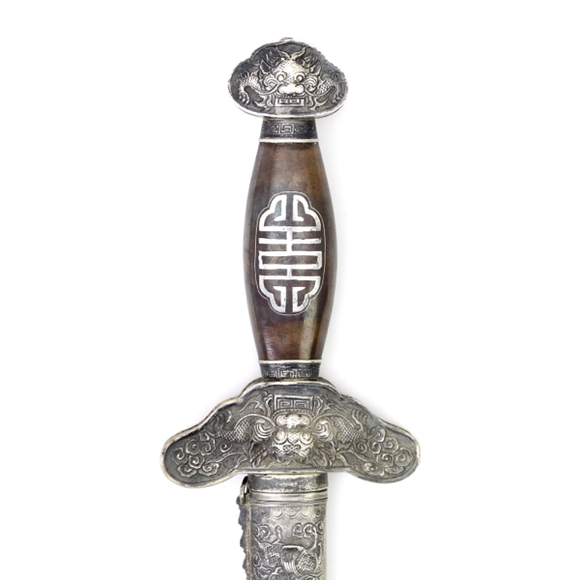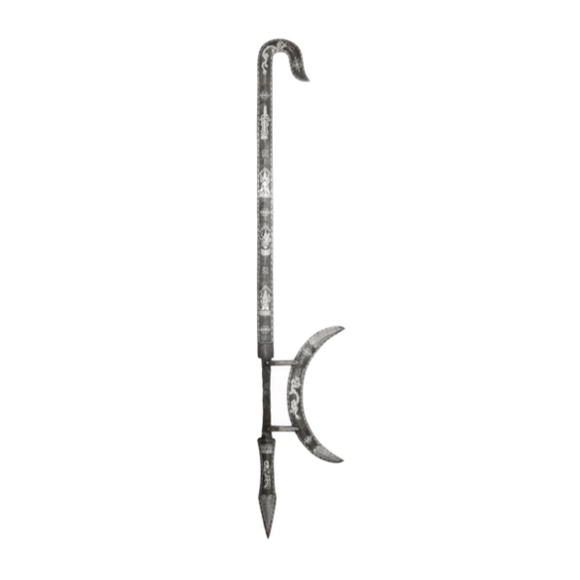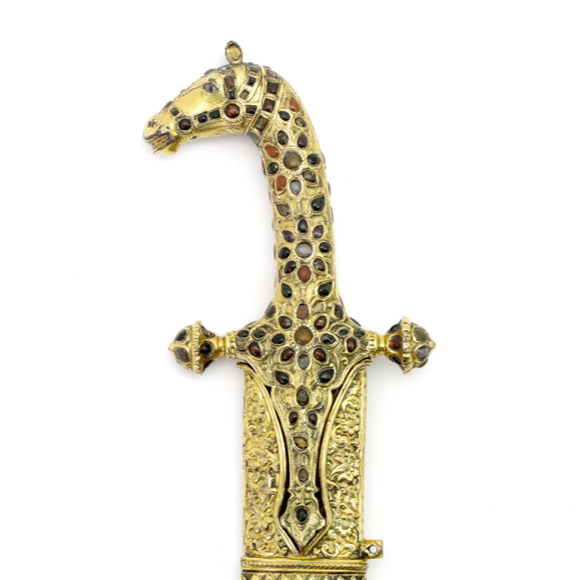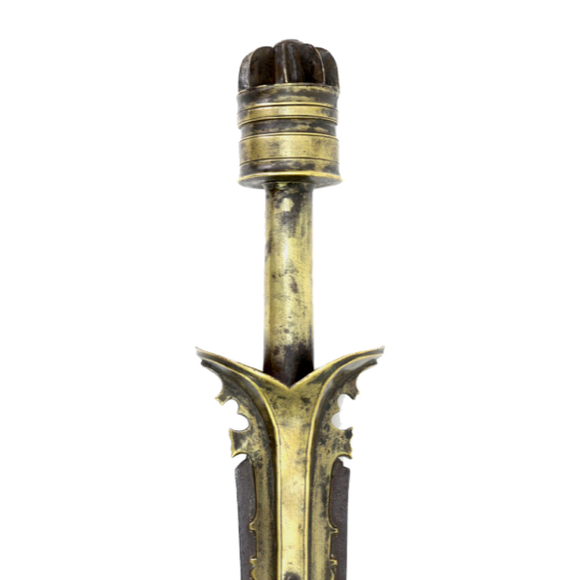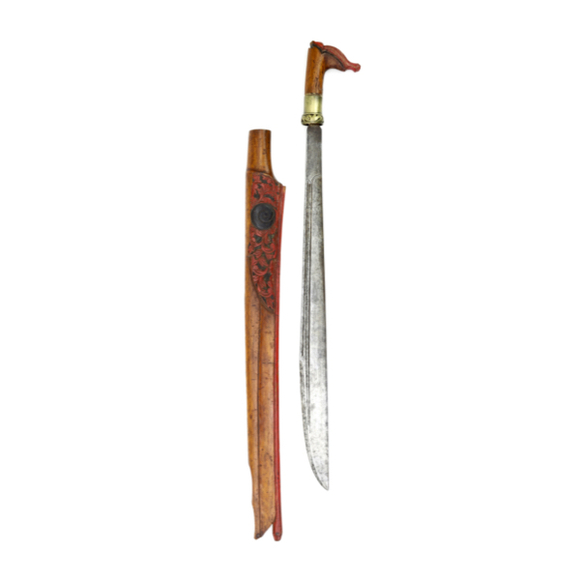A Chinese shortsword made by a well-known Longquan maker.

106.4 cm
90 cm
Base 8.5 mm
Middle 5 mm
5 cm from tip 2.5 mm
Base 19 mm
Middle 10 mm
5 cm from tip 8 mm
582 grams
10 cm from guard
14.5 cm from top of grip
The Low Countries
Iron, steel, silver wire, wood
1650 - 1680
This sword was sold in 2020.
Description
Among the small known group of chiseled iron smallswords, this example represents both the greatest complexity in design and fineness of execution.
Blade
The blade starts with a hexagonal cross-section at the base, gently merging into a lenticular cross-section further up the blade. The flat of the blade on either side is inscribed:
"INRII MARIA"
With further decorations of dots and a brass inlaid cross, framed by a narrow groove. It is interesting that the word INRI, which stands for IESVS NAZARENVS REX IVDÆORVM or "Jezus of Nazareth, King of Jews" is spelled with an additional I. Misspellings in markings were common on old European swords because most craftsmen were illiterate.
Hilt
The main attraction of the piece is the striking hilt, sometimes called "equestrian hilt" in collector's circles, for obvious reasons. The asymmetrical iron shell guard is chiseled in high relief with a scene of soldiers, mostly cavalry, storming a city gate. There is a large cannon to the lower right being loaded for firing, and there is a smaller cannon on the wall. Many of the swords and the horses' legs are undercut. The inside of the guard shows scenes of cavalry chiseled in low relief.
Under the guard is a strong ricasso that is chiseled with a rider on each side. From two monster heads on either side of the ricasso emerge the quillon, the knuckle guard, and the two pas d'âne rings. The quillon terminates into a galloping horseman.
The center of knuckle guard features three horsemen, the upper two are fighting on top of a slain one at the bottom. The upper figure is seen grasping the head of the middle figure, raising his saber to strike. Above them, another mythical monster's head.
The wooden grip is bound with silver wire, with on the top and bottom a braided band, sometimes called "Turk's head ferrule".
This tour de force of chiseling is topped off with an elaborate pommel, consisting of a series of horsemen chasing each other. The pommel exhibits the greatest sculptural qualities of the piece, with many of the horse's swords and legs being undercut.
Comparable examples
A series of smallswords with chiseled iron hilts was once in the notable Visser collection, where they are cataloged by Jan Piet Puype as being made primarily between 1655-1665. The majority of these have an equestrian theme, but biblical and classical themes are also encountered.1 The quality of the pieces varies, from simplistic to rather good, yet none of the published examples is on par with the piece described in this article.
One of the pieces, cat number 565, also shows the storming of a city wall on its guard. Above the gate, the year 1662 is chiseled.
Puype suspects they were probably made in the southeastern parts of the Netherlands, possibly Liège.
Condition
In near excellent condition throughout. No losses or damage to the chiseled hilt. Some loss to the brass inlaid cross on the blade. Some wear on the engravings on the blade. Some play in the wooden grip due to shrinkage of the wood.
Dating & attribution
Many of these pieces seem to be made by the same hand or the same workshop, and possibly represent an evolution towards ever more complex pieces of which this sword is the epitome. I would, therefore, tend to date it at the later end of the spectrum that Puype suggests (1655-1665), perhaps closer to 1665.
The mention of Maria on the blade indicates that it was made for a Catholic owner rather than the more common Protestant in the Netherlands of the time. Catholicism was officially banned in the Seven Provinces of the northern Low Countries, but was practiced in the southern "Spanish Netherlands" which was under Spanish rule at the time, and also in the Prince-Bishopric of Liège under which Liège fell at the time.
Provenance
The piece was previously in the Theodore Offerman collection. It was incorporated in the exhibition European Arms and Armor in the Brooklyn Museum in 1933. Apart from contributions by Theodore Offerman, it contained loans from Mrs. Bashford Dean, William Randolph Hearst, The John Woodman Higgins Armory, Carl Otto von Kienbusch, and others.
It appears in the accompanying catalog by Stephen V. Grancsay as:
"115. Sword. Dutch. XVII Century
Hilt Chiseled with mounted warriors and cannon etc. Blade inscribed: INRII MARIA. Illustrated."

The sword on top of the 1933 Brooklyn Museum catalog in which it is depicted.
Theodore Offerman passed away in 1937, after which his collection was auctioned at the American Art Association, Anderson Galleries, in New York. It was lot 268, offered in the second session held Friday afternoon, November 12th. It was described as:
"268. Sword. Dutch, XVII Century.
Steel hilt sculptured in high relief with battle scenes: blade inscribed on each face INRII MARIA.
Loan Exhibition of European Arms and Armor. Brooklyn Museum. 1933."

Illustration of the sword in the 1937 catalog.
A number of the items were acquired that day by Mr. Offerman's sister, Mrs. D. H. Schmidt, who presented them to the Metropolitan Museum of Art where they remain until today. 4
Conclusion
A notable Dutch smallsword with a chiseled iron hilt. It is part of a small group of smallswords with very similar work that appear to come from the same maker or shop. Within this group, it is the most complex in execution and represents the finest in workmanship. It was probably made around 1660-1665, most likely in the southern Catholic part of the Low Countries.
It comes with impressive provenance, as it can be traced back to the collection of Theodore Offerman and was exhibited in the Brooklyn Museum in 1933.
Notes
1. Jan Piet Puype; The Visser Collection, Arms of the Netherlands in the Collection of H. L. Visser. Volume 1, Part 3, pages 160-189.
2. Stephen V. Grancsay; European Arms and Armor. Brooklyn Museum. 1933. Page 20. Catalog number 116.
3. European Arms & Armor of the XV-XVIII century, Collection of the Late Theodore Offerman. American Art Association, Anderson Galleries, Inc. 1937. Lot number 268. See at archive.org.
4. Stephen V. Grancsay, Arms and Armor from the Theodore Offerman Collection. The Metropolitan Museum of Art Bulletin, Vol. 35, No. 2. February 1940. Pages 30-32.



















A very rare ceremonial variety with copper scabbard inlaid with different alloys, and a brass blade.
Typical Chinese hook sword, with seldom-seen fine silver wire overlay.
The style typical of Kutch, the execution far above what is normally seen on work from that area.
An early fighting piece with strong reinforcing langet and broad, cobra shaped tip.
Of typical South Borneo workmanship, but formed like a mandau from Kutai.

